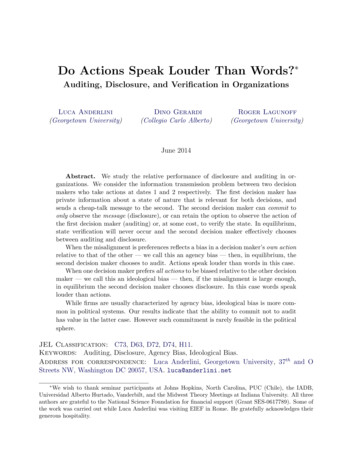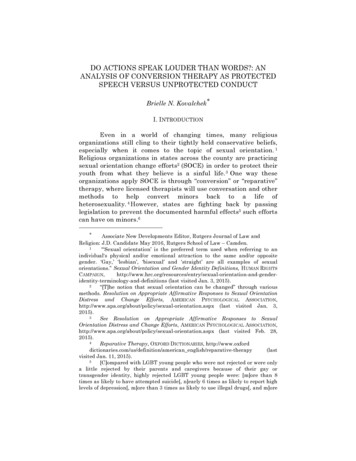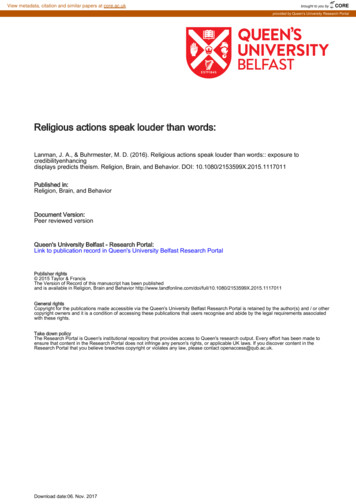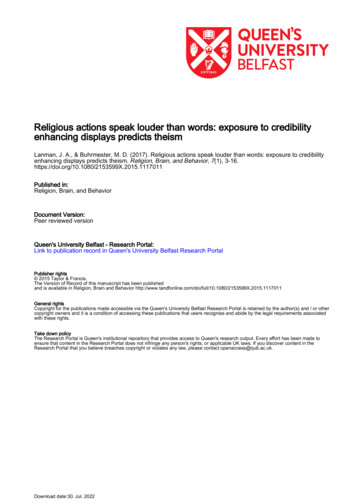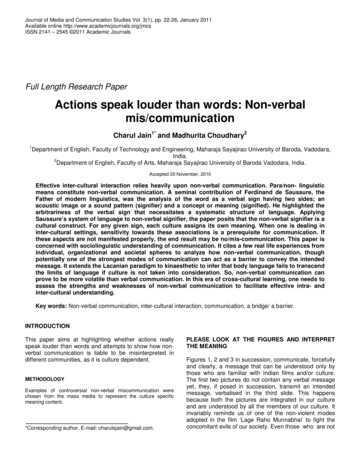
Transcription
Journal of Media and Communication Studies Vol. 3(1), pp. 22-26, January 2011Available online http://www.academicjournals.org/jmcsISSN 2141 – 2545 2011 Academic JournalsFull Length Research PaperActions speak louder than words: Non-verbalmis/communicationCharul Jain1* and Madhurita Choudhary21Department of English, Faculty of Technology and Engineering, Maharaja Sayajirao University of Baroda, Vadodara,India.2Department of English, Faculty of Arts, Maharaja Sayajirao University of Baroda Vadodara, India.Accepted 20 November, 2010Effective inter-cultural interaction relies heavily upon non-verbal communication. Para/non- linguisticmeans constitute non-verbal communication. A seminal contribution of Ferdinand de Saussure, theFather of modern linguistics, was the analysis of the word as a verbal sign having two sides; anacoustic image or a sound pattern (signifier) and a concept or meaning (signified). He highlighted thearbitrariness of the verbal sign that necessitates a systematic structure of language. ApplyingSaussure’s system of language to non-verbal signifier, the paper posits that the non-verbal signifier is acultural construct. For any given sign, each culture assigns its own meaning. When one is dealing ininter-cultural settings, sensitivity towards these associations is a prerequisite for communication. Ifthese aspects are not manifested properly, the end result may be no/mis-communication. This paper isconcerned with sociolinguistic understanding of communication. It cites a few real life experiences fromindividual, organizational and societal spheres to analyze how non-verbal communication, thoughpotentially one of the strongest modes of communication can act as a barrier to convey the intendedmessage. It extends the Lacanian paradigm to kinaesthetic to infer that body language fails to transcendthe limits of language if culture is not taken into consideration. So, non-verbal communication canprove to be more volatile than verbal communication. In this era of cross-cultural learning, one needs toassess the strengths and weaknesses of non-verbal communication to facilitate effective intra- andinter-cultural understanding.Key words: Non-verbal communication, inter-cultural interaction, communication, a bridge/ a barrier.INTRODUCTIONThis paper aims at highlighting whether actions reallyspeak louder than words and attempts to show how nonverbal communication is liable to be misinterpreted indifferent communities, as it is culture dependent.METHODOLOGYExamples of controversial non-verbal miscommunication werechosen from the mass media to represent the culture specificmeaning content.*Corresponding author. E-mail: charulsjain@gmail.com.PLEASE LOOK AT THE FIGURES AND INTERPRETTHE MEANINGFigures 1, 2 and 3 in succession, communicate, forcefullyand clearly, a message that can be understood only bythose who are familiar with Indian films and/or culture.The first two pictures do not contain any verbal messageyet, they, if posed in succession, transmit an intendedmessage, verbalised in the third slide. This happensbecause both the pictures are integrated in our cultureand are understood by all the members of our culture. Itinvariably reminds us of one of the non-violent modesadopted in the film ‘Lage Raho Munnabhai’ to fight theconcomitant evils of our society. Even those who are not
Jain and ChoudharyFigure 1. Three monkeys.Figure 2. A bouquet of flowers.Figure 3. A get-well-soon card/message.23acquainted with Indian films will get the implied meaningof the message, if they have knowledge of Gandhianprinciples and certain constructs of our culture. Themessage, thus, would be more effectually communicatedthrough non-verbal mode than verbal mode.Communication, in general, verbal or non-verbal, is oneof the basic necessities of human life; perhaps, asintegral and as vital as our breath. Humans sustainthemselves in the society through interaction with fellowbeings. Communication, a derivation of a Latin term‘communico’ means ‘to share’. If we accept this meaningthen we also will not be able to ignore its sociologicalaffiliation as Scheflen (1972) argued that communicationincludes all behaviours by which a group forms, sustains,mediates, corrects and integrates its relationships. In anycultural and linguistic group, the flow of interactionindicates the states of each participant and theirrelationships. All individuals that are contained within agroup learn these behavioural patterns since childhood.They all ascribe same communicative interpretations tothese activities when any member in an interactivesituation performs them. By its very nature, it implies atleast two participants in the communicative situation; oneactive who encodes and transmits the information andthe other, who receives and decodes the message. Themessage can be encoded verbally (using lexical items ofa language system) or through non-verbal means (usingsigns, symbols, postures, gestures, etc.) Non-linguisticcommunication is further classified into three fields:Kinesics (body semantics), metalinguistics (vocalizationsand interjections) and Proxemics (spatial arrangements).Abercrombie, one of the proponents of the study ofparalanguage believes, “We speak with our vocal organsbut we converse with our entire bodies; conversationconsists of much more than a simple interchange ofspoken words” (Abercrombie, 1972: 67). These nonlinguistic elements may occur independently or alongsidespoken language. For instance, Franklin Southworth inhis insightful essay “South-Asian Emblematic Gestures”points out that there are as many as nine different nonverbal modes to greet someone and each mode is culturespecific (Southworth, 1992: 110- 111). These behavioursare regular, uniform and mutually owned within a cultureand their expression is so familiar to all in that contextthat they lead to immediate recognition and instantaneous interpretation by all the members of that linguisticcommunity. Scheflen correctly points out, “Such paralexical behaviours occur in characteristic, standard configurations, whose common recognizability is the basis oftheir value in communication” (Scheflen, 1972: 225). It isa popular notion that these non-linguistic items cut acrosslanguage and culture boundaries. Our intention in thispaper is to posit and prove, with the help of a few real lifeexperiences from individual, organisational and societalspheres that these behavioural patterns are culturallydetermined and differ among social groups, languages,and nations.
24J. Media Commun. Stud.The messages conveyed through non-verbal mode aresusceptible to misinterpretations in trans-cultural situations. For example, the expression of two of the simplestand commonest ideas, ‘yes’ and ‘no’ varies from oneculture to another. A rocking of head forward and backward, in vertical axis is a general indication of affirmationwhereas rotation from left to right on a horizontal levelhas normally been accepted to be negation. Manycultures including Japanese do not give these indicationsby nod of the head; instead, they use hand gestures toconvey affirmation or negation. Move-ment of right handsignals negation whereas both the hands together in aspecific movement are used to indicate ‘yes’ (La Barre,1972: 207). A particular tribe of Malaya cast their eyesdown to indicate ‘no’, whereas the same gesture made byIndian girls indicates acceptance. When a teacher asks inclass whether students have understood or not, somestudents nod their heads up and down, while some tilttheir heads to either side in an up and down motioninstead of standing up and answering verbally. Thesenods can be interpreted differently; for instance inWestern India, nodding the head from side to side means‘yes’ whereas in Northern India, tilting of heads in an upand down motion indicates ‘yes’.Proxemics, one of the types of non-verbal communication is a culture sensitive communication symbol. Thedistance between people reserved for categories ofacquaintance vary depending on the cultural interprettation of the distance. When involved in cross-culturalcommunication, understanding these variations ofproxemic symbols is essential to maintaining effectivecommunication. For instance, Hungarians are relativelynon-tactile and they like to maintain personal space,whereas Italians are the most touch friendly people inEurope. Thus, for some cultures, the Proxemics iscompressed, whereas, for some it may be expanded. Thepersonal zone of the Middle East and the Arab world issmaller than that of the West. Man will stand much closerto other men when holding a conversation than is usual inthe West. In Indian subcontinent, it is acceptable to havetactile contact with a person of the same sex but notinter-sexually. Men shake hands, hug and pat each other.Women too hug or even clasp each other firmly. But aman would think twice before extending his hand to awoman even for a formal handshake. In westerncountries, it is quite acceptable between a man and awoman to shake hands or even to peck each other at thecheeks (Clayton, 2006: 142-150).In India, recently, a controversy was raked up when themain actors in a film were shown in an intimate kissingscene. Such a scene would be absolutely inoffensive inwestern culture but was made into an image-threateningissue in Indian context.Some more instances of gestures leading to crosscultural misunderstanding and uproar are:1. In November 2006, after winning their maidensChampion Trophy, Australian Cricket Team Captain,Ricky Ponting waved his fingers at BCCI President,Sharad Pawar signalling him to come and hand over thetrophy. Later one of the Players, Damien Martyn, tappedat Pawar and nudged him out of the stage. Indians andAustralians reacted differently to this episode. The mediaas well as some sports celebrities in India called it “awilful and intentional” and cricket fans in India were up inarms whereas Dean Jones, former Australian cricketer,said, “It looks like the Aussies are treating it as no bigdeal”.2. Another controversy erupted when in Kolkata, inNovember 2005; TV cameras filmed Greg Chappell,Indian cricket team coach, making what appeared to be agesture to some hecklers as he boarded the Indiancricket team’s bus. Chappell’s alleged offensive andobscene gesture had drawn angry response in the citywith politicians and prominent personalities denouncing itwhile the Indian team management denied it and saidthat he was only attending to an injured finger.3. Referring to some bodily gestures like belching,burping, spitting and breaking wind, Pathiyan in herarticle in The Sunday Times states that though they are“universal gestures”, they are “unabashedly” executed inpublic by Indians. Later in the essay she quotes from ahomemaker’s blog “burping is not about feeling guilty. Onthe contrary it is about being content with food that youhave eaten and about giving the hosts a compliment”(Pathiyan, 2006: 1).With the aforementioned instances, we try to bear outthat through non-verbal signs of communication; peoplemay unintentionally offend someone and thus consequentially expose themselves to the peril ofmiscommunication.A seminal contribution of Ferdinand de Saussure, theFather of modern linguistics, was his analysis of the wordas a verbal sign having two sides – an acoustic image ora sound pattern (signifier) and a concept (signified). Hesaw the arbitrariness of the verbal sign that necessitatesa systematic structure of language. Symbols and wordsare concrete signs, which represent relatively abstractideas. For example, a concrete non-verbal pictographicsign, ‘the skull and cross bones’ stands for ‘danger’ andthe word ‘book’ is a verbal symbol and it refers to ‘sheetsof papers bound together’. Because all signs are arbitraryand there is no logical reason why we use one particularsign, meaning is generated when we combine the‘producer’ who uses the signified, the signifier, the‘consumer’ who is the destination of the text/messageand the ‘message/text’. Combining these three factors, ageneral model of semiotics was developed as shown inFigure 4.Saussure’s analysis of the ‘word’ stands valid for allsigns, verbal or non-verbal. Though arbitrary, a sign hasmeaning in its respective linguistic or cultural context.Saussure had argued that a sign has a meaning only
Jain and Choudhary25Figure 4. General Model of Semiotics (Beck et aI., 2004: 25).Figure 5. Reworked Model of Semioticswithin its system or some related context. It is not anautonomous body. He stressed the importance ofconsidering each sign in relationship to all other factorswithin the system. While interpreting non-verbal sign,thus, one needs to consider culture as a major factor.Inclusion of culture becomes necessary because whenwe communicate through signs, we are also offering datato the world. We provide information about our attitudes,our culture, and ourselves. So, a reworked model ofsemiotics can be assumed which will include the
26J. Media Commun. Stud.producer’s and the receiver’s ‘culture’ as shown in Figure5.Following the lead given by Kroeber and Kluckhohn inthe late twentieth century, by Redfield and others, BrianBullivant defines culture as:“The generalised composite of interdependent andvalued traditional and current public knowledge andconceptions,embodiedin behaviours andartefacts to give meaning to and cope with itsdefinitions of present and future existentialproblems” (Bullivant, 1986: 43).Thus, in essence, culture is dynamic in nature, yet isfounded on certain static values and principles. Thesevalues can pose problems in communication, becausetraditional values and norms are divergent in differentcultures. The paradigm proposed by Charles SandersPeirce, an eminent American philosopher in thenineteenth century, of icon, index and symbol bears aclose relationship between communication and culture(Abrams, 1993: 276).Applying Lacanian paradigm of innate figurativeness oflanguage to non-verbal communication, one can infer thatlanguage is transparently referential (Lacan, 2004: 62).Non-verbal language will fail if one does not relate it toculture, religion and other factors. This form of interactionis much more limited than the verbal mode if it is usedseparately. Consequently, interpersonal interactions havegained vital importance due to widening horizons ofintercultural communications. This mode of communication as modifier, substitute or reinforcement has thepotential to form a parallel signalling system if it isinterspersed with verbal output (Southworth, 1992: 104).Meaning is a social fact, which comes into being withinthe discourse of a culture (Ashcroft, 1995: 298). It is theresponsibility of the speaker in a cross-cultural situationto employ techniques that would ‘situate’ the action forthe listener/spectator. The same can be applied to nonverbal communication.Non-verbal communication, though potentially one ofthe strongest modes of communication can act as abarrier to convey the intended message. In recent times,non-linguistic communications have become all the morecritical in defining and displaying meanings andintentions. In this era of cross-cultural learning, oneneeds to evaluate the strengths and weaknesses of nonverbal communication that is universally hailed as themost effective mode because it has no languageconstraints. Much has been written and said about thepositive aspects of this mode but this paper is an effort toprovide a holistic understanding of its limitations.REFERENCESAbercrombie D (1972). Paralanguage. In Laver, J. & Hutcheson, S(Ed.), Communication in Face to Face Interaction. Middlesex:Penguin Books Ltd., pp. 64-70.Abrams M (1993). A Glossary of Literary Terms. Bangalore: PrismBooks Pvt. Ltd.Ashcroft B (1995). Constitutive Graphonomy. In Ashcroft, B, Griffiths, G.& Tiffin H (Ed.), The Post-Colonial Reader. London: Routledge, pp.298-302.Beck A, Bennett P, Wall P (2004). As Communication Studies: TheEssential Introduction. India: Routledge.Bullivant B (1986). Towards Radical Multiculturalism: ResolvingTensions in Curriculum and Educational Planning. In Modgil, S,Verma, G., Mallick, K. &Modgil, C. (Ed.) Multicultural Education: TheInterminable Debate. Philadelphia: The Falmer Press.Clayton P (2006). Body Language at Work. (2nd Ed.) New Delhi: OmBooks International.La Barre W (1972). The Cultural Basis of Emotions and Gestures. InLaver, J. & Hutcheson, S (Ed.), Communication in Face to FaceInteraction (pp207-224). Middlesex: Penguin Books Ltd.Lacan J (2004). The Insistence of the Letter in the Unconscious. InLodge, D., Wood, N. (Ed.), Modern Criticism and Theory: A Reader(2nd Ed.) (pp. 61-87). New Delhi: Pearson.Pathiyan P (2006) Say Cheee! Times Life: The Sunday Times of India.Scheflen A (1972). The Significance of Posture in CommunicationSystems. In Laver, J. & Hutcheson, S. (Ed.), Communication in Faceto Face Interaction. Middlesex: Penguin Books Ltd., pp. 207-224.Southworth F (1994). South Asian Emblematic Gestures. In Dimock, E.,Kachru B, Krishnamurti B (Ed.), Dimensions of Sociolinguistics inSouth Asia. New Delhi: Oxford & IBH Publishing Co. Pvt. Ltd. pp. 99112.
Key words: Non-verbal communication, inter-cultural interaction, communication, a bridge/ a barrier. INTRODUCTION This paper aims at highlighting whether actions really speak louder than words and attempts to show how non-verbal communication is liable to be misinterpreted in different communities, as it is culture dependent.

